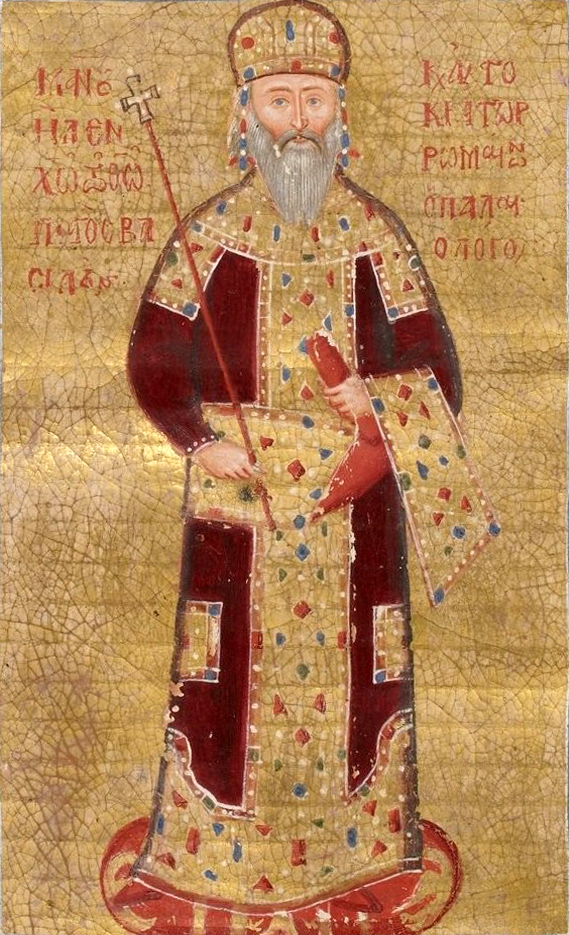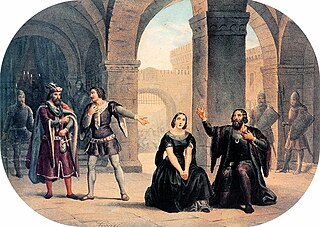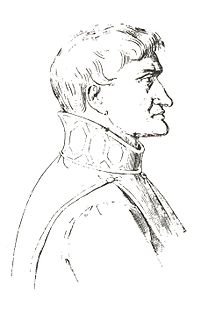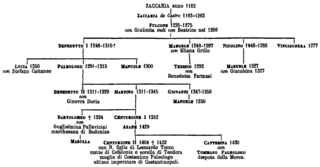
Manuel II Palaiologos or Palaeologus was Byzantine Emperor from 1391 to 1425. Shortly before his death he was tonsured a monk and received the name Matthew. His wife Helena Dragaš saw to it that their sons, John VIII Palaiologos and Constantine XI Palaiologos, become emperors.

John IV Doukas Laskaris was emperor of Nicaea from August 18, 1258, to December 25, 1261. This empire was one of the Greek states formed from the remaining fragments of the Byzantine Empire, after the capture of Constantinople by Roman Catholics during the Fourth Crusade in 1204.

Michael VIII Palaiologos or Palaeologus reigned as the co-emperor of the Empire of Nicaea from 1259 to 1261, and as Byzantine Emperor from 1261 until his death. Michael VIII was the founder of the Palaiologan dynasty that would rule the Byzantine Empire until the Fall of Constantinople in 1453. He recovered Constantinople from the Latin Empire in 1261 and transformed the Empire of Nicaea into a restored Byzantine Empire.

John VII Palaiologos or Palaeologus was Byzantine Emperor for five months in 1390. While he was Emperor, there is evidence showing he used the name Andronikos, after his father, although when he was regent during his uncle's absence in the West, he governed in his birth name.

Baldwin II, also known as Baldwin of Courtenay or Baldwin the Broke, was the last Latin Emperor ruling from Constantinople.

The Sicilian Vespers was a successful rebellion on the island of Sicily that broke out at Easter 1282 against the rule of the French-born king Charles I, who had ruled the Kingdom of Sicily since 1266. Within six weeks, approximately 13,000 French men and women were slain by the rebels, and the government of King Charles lost control of the island. It was the beginning of the War of the Sicilian Vespers.

Les vêpres siciliennes is a grand opera in five acts by the Italian romantic composer Giuseppe Verdi set to a French libretto by Eugène Scribe and Charles Duveyrier from their work Le duc d'Albe, which was written in 1838. Les vêpres followed immediately after Verdi's three great mid-career masterpieces, Rigoletto, Il trovatore and La traviata of 1850 to 1853 and was first performed at the Paris Opéra on 13 June 1855.

The War of the Sicilian Vespers or just War of the Vespers was a conflict that started with the insurrection of the Sicilian Vespers against Charles of Anjou in 1282 and ended in 1302 with the Peace of Caltabellotta. It was fought in Sicily, Catalonia and elsewhere in the western Mediterranean between, on one side, the Angevin Charles of Anjou, his son Charles II, the kings of France, and the Papacy, and on the other side the kings of Aragon. The war resulted in the division of the old Kingdom of Sicily; at Caltabellotta, Charles II was confirmed as king of Sicily's peninsular territories, while Frederick III was confirmed as king of the island territories.
Nikephoros I Komnenos Doukas, Latinized as Nicephorus I Comnenus Ducas, was ruler of Epirus from 1267/8 to c. 1297.

John of Procida (1210–1298) was an Italian medieval physician and diplomat.

Benedetto I Zaccaria was an Italian admiral of the Republic of Genoa. He was the Lord of Phocaea and first Lord of Chios, and the founder of Zaccaria fortunes in Byzantine and Latin Greece. He was, at different stages in his life, a diplomat, adventurer, mercenary, and statesman.

Lu rebellamentu di Sichilia, fully Cronica di lu rebellamentu di Sichilia contra re Carlu, is a Sicilian historical chronicle of the War of the Vespers written around 1290. The anonymous Rebellamentu, probably written at Messina, was ascribed to Atanasiu di Iaci by Pasquale Castorina in 1883. Though the Rebellamentu sometimes adds valuable details to the history of the Vespers, it is frequently untrustworthy. Its monastic provenance is evident in its moralising tone. The antiquity of its language has placed its authenticity beyond doubt, despite its lack of an early manuscript tradition. This has not prevented speculation that it was written contemporarily with events: one verb in one manuscript is found in the first-person present; this may represent the author inadvertently stepping out of his usual frame of reference, or merely an error in that manuscript.
The Leggenda di Messer Gianni di Procida is a short medieval Tuscan history of the Sicilian Vespers, synoptic with another early Tuscan account, the Liber Jani de Procida et Palialoco. Both texts focus on the conspiratorial role played by John of Procida, who is cast as a villain. A contemporaneous Sicilian writing, Lu rebellamentu di Sichilia, portrays John as a hero. Both Tuscan versions are later than the Sicilian, but may share the Reballamentu as a source. Conversely, all three may derive from an earlier, now lost source. All three agree on the centrality of John of Procida in the Vespers.

Constantine Palaiologos or Palaeologus was a Byzantine nobleman and the younger half-brother of the Byzantine Emperor Michael VIII Palaiologos.

The Battle of Neopatras was fought in the early 1270s between a Byzantine army besieging the city of Neopatras and the forces of John I Doukas, ruler of Thessaly. The battle was a rout for the Byzantine army, which was caught by surprise and defeated by a much smaller but more disciplined force.

The Siege of Berat in Albania by the forces of the Angevin Kingdom of Sicily against the Byzantine garrison of the city took place in 1280–1281. Berat was a strategically important fortress, whose possession would allow the Angevins access to the heartlands of the Byzantine Empire. A Byzantine relief force arrived in spring 1281, and managed to ambush and capture the Angevin commander, Hugo de Sully. Thereupon, the Angevin army panicked and fled, suffering heavy losses in killed and wounded as it was attacked by the Byzantines. This defeat ended the threat of a land invasion of the Byzantine Empire, and along with the Sicilian Vespers marked the end of the Western threat to reconquer Byzantium.

The Battle of Prinitza was fought in 1263 between the forces of the Byzantine Empire, marching to capture Andravida, the capital of the Latin Principality of Achaea, and a small Achaean force. The Achaeans launched a surprise attack on the greatly superior and overconfident Byzantine force, defeated and scattered it, saving the principality from conquest.
Gazo Chinard (1230–1294) was an Italian noble lord, brother or son of Philippe Chinard and vassal of Manfred of Sicily and Charles of Anjou. After the assassination of Philippe Chinard by Michael II of Epirus, Gazo enraged by the act, handed over the territories to Charles of Anjou, who in return appointed him as captain general of Corfu.

I vespri siciliani is a five-act Italian opera originally written in French for the Paris Opéra by the Italian romantic composer Giuseppe Verdi and translated into Italian shortly after its premiere in June 1855.

Irene Komnene Laskarina Branaina was a Byzantine noblewoman and wife of sebastokrator Constantine Palaiologos, half-brother of Byzantine Emperor Michael VIII Palaiologos. She seems to have followed suit after her husband's retirement to a convent, and taken the monastic name of Maria. She probably died as a nun.